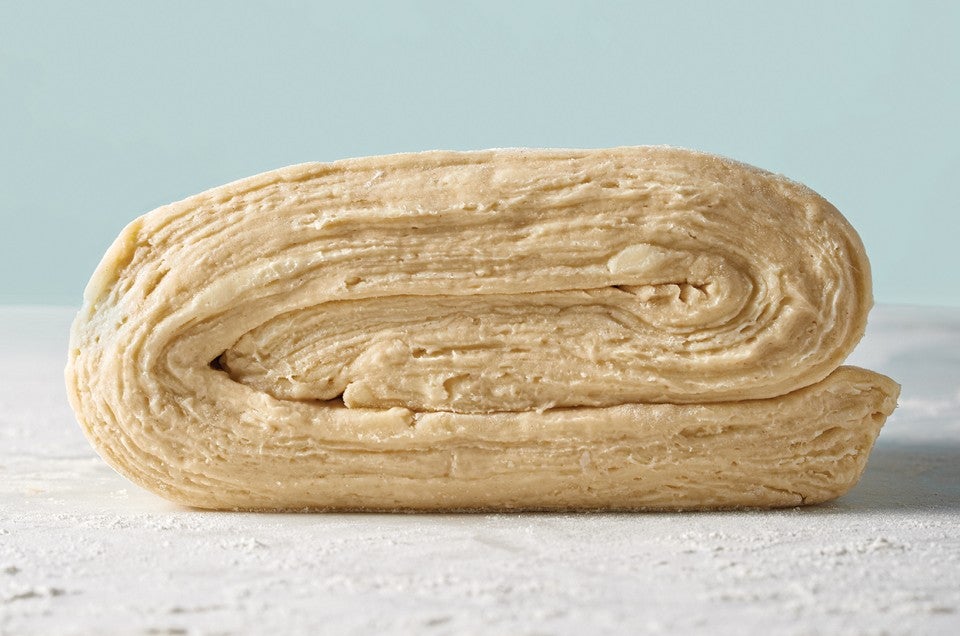-
To make the dough: Weigh your flour; or measure it by gently spooning it into a cup, then sweeping off any excess. Combine the flour and salt in a large mixing bowl.
-
Cut the butter into small pieces and drop them into the bowl with the flour. With a pastry blender or your fingertips, cut or rub the butter into the flour until it resembles cornmeal.
-
Add the cold water to the bowl. Mix gently with your hands, a fork, or a dough scraper until you have a rough, slightly tacky dough that pulls away from the sides of the bowl.
-
Turn the dough out onto a lightly floured surface and knead it until it's smooth and the gluten has developed somewhat, 2 to 3 minutes.
-
Pat the dough into a 9" square and wrap it in plastic or a reusable wrap. Refrigerate the dough for at least 30 minutes.
-
To prepare the butter block: Mix together the flour and butter until they're well blended and smooth. You can do this with a mixer, a food processor, or by hand with a spoon.
-
Pat the butter/flour mixture into an 8" square on a lightly floured piece of parchment or waxed paper. Cover it with a second sheet of paper and refrigerate it for at least 30 minutes.
-
To prepare (laminate) the dough: Remove the dough from the refrigerator and put it on a lightly floured surface. Gently roll it into a 12" square. You don't have to be obsessive about the dimensions but do try to come pretty close.
-
Place the chilled butter in the center of the dough at a 45° angle, so it looks like a diamond in a square. Fold the corners of the dough over the butter until they meet in the middle. Pinch and seal the edges of the dough together.
-
Turn the square over and tap it gently with your rolling pin (or hands) into a rectangular shape. Make sure everything is still completely (though lightly) floured. Roll the dough into a 20" x 10" rectangle. As you work keep the dough, the table, and the rolling pin well dusted with flour. Turn the dough over from time to time to keep the layers even.
-
When the dough is the right size, brush any excess flour off the top, and fold the bottom third of the dough up to the center and the top third over (like a business letter). Line the corners up as neatly as you can; dab them with a little water to help them stick together if necessary, and turn the dough package 1/4 turn to the right so it looks like a book ready to be opened. If the dough is still cold and relaxed, do another rolling and turning the same way. If it begins to feel too soft or wants to resist being rolled, cover it, put it on a small baking sheet, and refrigerate it for 15 minutes to chill and relax.
-
If you've successfully rolled it out and folded it twice, you've completed two turns. Classic puff pastry gets six. Continue refrigerating it after each two turns (or more often if necessary) until all six turns are completed. Keep track of how many turns you've made.
-
When all six turns are done, put the dough in the refrigerator for at least an hour (preferably 3 or 4 hours).
-
On a lightly floured surface, roll the dough until it's a rectangle about 12" x 18". Trim 1/4" off the edges of the dough all the way around with a very sharp knife or a pizza wheel. This removes the folded edges, which would inhibit the "puff."
-
Cut and shape the pâte feuilletée as your recipe suggests. Use this delicious homemade pastry in any recipe calling for purchased frozen puff pastry sheets, and taste the difference!
-
Storage information: To use pâte feuilletée later, fold it up like a letter, double wrap it, and refrigerate for up to two days. Freeze for up to six months. If frozen, thaw overnight in the refrigerator before using.


















